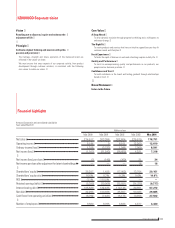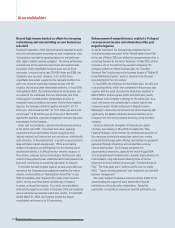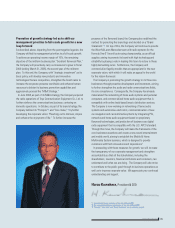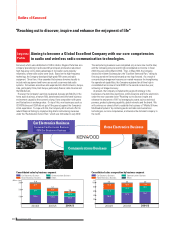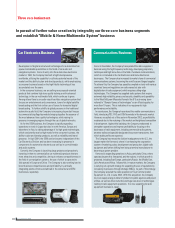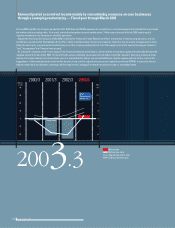Kenwood 2004 Annual Report Download - page 13
Download and view the complete annual report
Please find page 13 of the 2004 Kenwood annual report below. You can navigate through the pages in the report by either clicking on the pages listed below, or by using the keyword search tool below to find specific information within the annual report.
Profitability (30% Cost Reduction)
Cash Flow (50% Inventory Reduction)
Defect Rate Reduce to 1/4
Unified Community KENWOOD Group
KENWOOD Quarter QCD Revolution
Reduction Cost and Administrative Expenses Reduction 1/4
Manufacturing-to-Sales Lead Time Reduce to 1/4
Quality
Cost
Delivery
Transition of inventory and receivables
Inventory Trade notes and accounts receivable
(Billions of yen)
60
0
20
40
2003/32002/3 2004/3
Transition of cash flow
Cash flows from operating activities Cash flows from investing activities
(Billions of yen)
30
-30
-15
0
15
2003/32002/3 2004/3
Cash flows from financial activities
57.6
43.3
34.6
32.3 30.9
24.6
-6.8
-5.9
-12.8
-8.0
10.4
-7.7
15.2 1.0
27.5
Transceiver system provided to West Maclaren
Mercedes Team, as an official supplier
Production innovations-Best practice reflected on all
production sites at home and abroad
In March 2003, the Company launched a production innovation project to further
improve profits and cash flows through "Kenwood Quarter QCD (quality, cost and
delivery) Revolution"-the supply chain management (SCM) overhaul targeting
production, marketing and technology. The themes of the project were "revival of
domestic plants to outdo Asian peers" and "reinforcing overseas plants'
competitiveness."
The best practical example for the project was the return of the production of
portable MD players for the Japanese market from the Malaysian plant to the
factory in Yamagata (Japan), where manufacture resumed in September 2003.
The move resulted in a reduction in costs, a substantial cut in the lead time from
manufacturing to marketing, and a decrease in the percentage of defective
products, which helped turn a profit in the home electronics business in the
second half of the year and contributed to improving cash flows.
In a similar move, the Company shifted the production of "Theater Navi," a high
potential audio-visual hard disc navigation system, from the Nagano plant to the
Yamagata factory, where manufacture of the product started in January 2004,
while positioning the Nagano plant as the main production center of OEM car
electronics products. This production innovations were adopted in the car
electronics business. Through these moves, the Company established a system
to propagate best practice methods at all manufacturing bases both in Japan and
overseas.
As a result, inventories decreased approximately 7.7 billion yen from the
previous year. Cash flows from operating activities increased about 17.1 billion
yen, marking a significant improvement, due to cuts in inventories, a sharp rise in
net income and a reduction in accounts receivable due to restructuring of
marketing functions. In addition, indirect fixed costs and direct processing costs
declined, wastage costs decreased thanks to improved product quality, and
procurement costs went down owing to innovative procurement activities.
Reduction in these costs translated into an increase in earnings for every
business division.
Development of new product lines
The Company strove to develop new product lines leveraging its core
competencies, "audio" and "radio communication" technologies, aiming to
establish the "Mobile & Home Multimedia Systems" business.
In the car electronics business, the Company enjoyed strong sales of DVD
theater systems that use proprietary audio and multimedia technologies, as well
as "Theater Navi," an audio-visual hard disc navigation system that integrates
DVD theater and automotive navigation systems for the domestic market. The
Company strengthened its multimedia equipment lines, through development of
tuners for digital satellite broadcasting (provided by Sirius Satellite Radio, Inc. of
the United States) and the first civilian use of tuners for terrestrial digital
broadcasting high definition radios, both for the U.S. market. Sales of multimedia
and mechanical systems fared well, and the Company stepped up their
production. Accordingly, its OEM business expanded remarkably.
In the communications business, the Company focused on developing digital
radio communication terminals and radio communication systems in response to
the digitalization wave affecting radio communication domain.
In the home electronics business, the Company, concentrating its efforts on
home theater systems, pure audio equipment and portable audio devices,
developed digital amplifiers with high quality and next-generation network-based
audio systems, as well as products with excellent tone quality by stepping up
research on tone quality.
Reinforcement of the brand
After its start as a reborn Kenwood, the Company strove to rebuild its brand,
aiming to increase its global presence. In January 2004, the Company launched a
brand management project, in which Group staff around the world joined, to
work on a brand strategy to provide new value to the market. The Company also
signed an official supplier contract with McLaren-Mercedes Racing to provide the
renowned team with its radio communication equipment for the Formula One (F-
1) world auto-racing championship.
Kenwood Corporation 13


